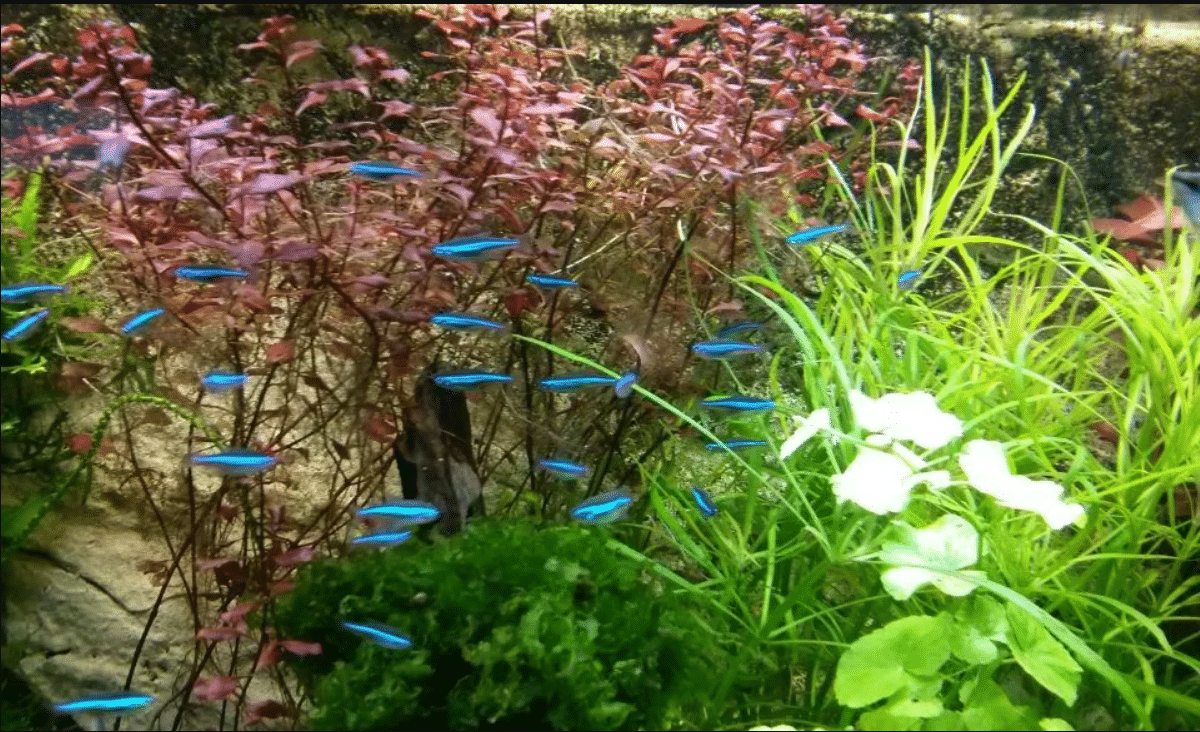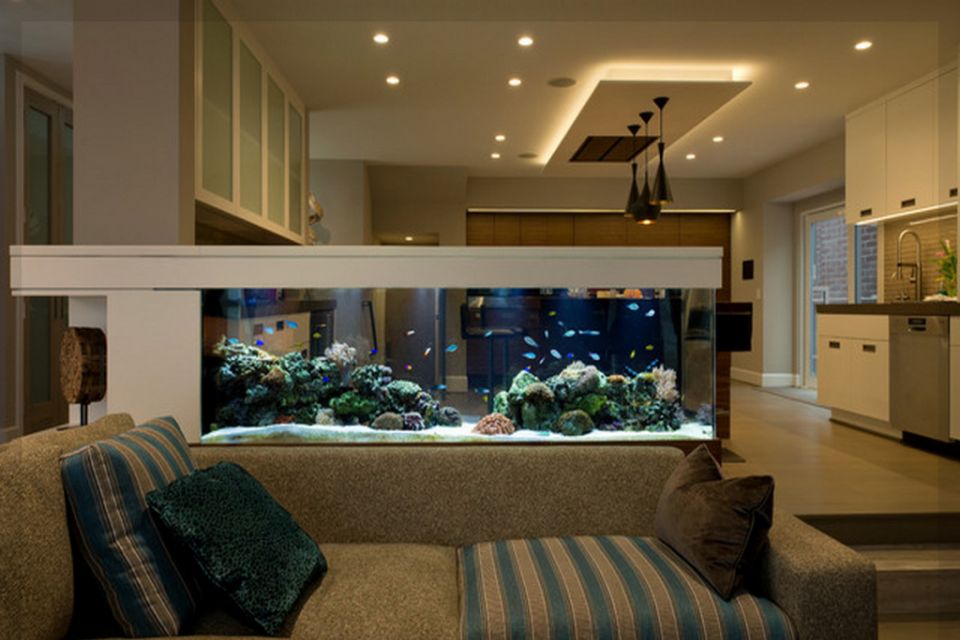Keeping blue neons in the aquarium
Who looks for fish for its aquarium, falls back gladly on tetra because they are small, relatively easy-care and with its often shining colors a real eye-catcher.
A particularly beautiful specimen of this genus is the blue neon (lat. Paracheirodon simulans). This is a freshwater ornamental fish that can reach a length of 3 to 3.5 centimetres and can live up to five years. Its attitude in the aquarium is relatively simple. The following is a precise breakdown of the demands the little swimmer makes of his surroundings.

Table of Contents
Where does the blue neon occur?
The blue neon is a tropical fish and originates from South America. There it cavorts mainly in the upper part of the Rio Negro, the upper Amazon basin and the Orinoco.
What distinguishes the Blue Neon?
The blue neon belongs to the tetra family and looks very similar to the red neon and the neon tetra, but is biologically not related to them. Nevertheless, the animals look very similar and it is not uncommon for confusion to occur when buying. One can distinguish the neons quite simply as follows:
| red neon | solid red bar (under the blue bar) |
| neon tetra | half red bar (under the blue bar) |
| Blue Neon
|
no red bar (under the blue bar) |
The blue neon is the smallest of its genus, but probably the most beautiful due to its high blue content.
All three species have both a red and a blue portion. The blue neon, however, is the only one to have a continuous blue fluorescent stripe that extends over the entire length of the body.
The fins are whitish transparent, the lower part of the head and the rear part of the stomach are coloured red, this has in common with the red neon as well as the neon tetra. Keeping blue neons in the aquarium

Which water values and temperature does the blue neon prefer?
For a good attitude in the aquarium there are some things to consider. For the Paracheirodon simulans to feel comfortable in its home, the perfect aquarium should have the following characteristics:
| Size: | min. 80 cm (approx. 112 litres) |
| Temperature: | 20° C – 26° Celsius |
| PH value: | by 5.0-6.0 |
| Water hardness: | 3-10° dGH |
| Carbonate hardness: | 0-6° dKH |
A total water hardness of 8 is optimal, with a carbonate hardness of 4. The pH value can also be 7 if necessary, but care should be taken that it does not slip into the alkaline range.
The use of rainwater or osmosis water is recommended to achieve the specified values.
Osmosis water is pure water which has been freed from all substances dissolved in it. It can be easily produced using a standard osmosis system. Normal tap water is filled into the system, where it is pressed through a membrane that only allows water molecules to pass through. All other substances are filtered out and disposed of in the waste water. If this is too cumbersome for you, you can also buy processed osmosis water in the shop.
A CO2 plant can also not harm, since the blue neon prefers a densely overgrown aquarium and CO2 is indispensable for many tropical aquarium plants. CO2 supplies the aquatic plants with sufficient gas they need for photosynthesis, enabling them to grow faster and displace algae at the same time. At the same time it lowers the pH value of the water to approx. 6.5.
With the indicated temperatures it is to be noted that the Paracheirodon simulans is a tropical fish, which lives in the warm water. The temperature in the aquarium must not fall below 20 °C under any circumstances. Upwards there are also maximum values of up to 32 °C circulating on the Internet. However, an upper limit of 23 °C is often indicated as optimal, because the blue neon likes the water in contrast to its close relatives, the red neon and the neon tetra, a little colder.

How do you hold blue neon? |Keeping blue neons in the aquarium
The blue neon is a real schooling fish. He only feels like he’s in a group that protects him. To achieve this protection you should use at least 10-12 animals in small aquariums from 80 liters. Nevertheless its swarm behavior becomes really clear only starting from a quantity of 25-30 animals, why it is my recommendation to hold the animals only in larger basins, like a 180-240 litre aquarium.
To see if you have enough Blue Neon in your aquarium (this is especially useful in large tanks) you should observe your group a little bit. If the animals swim again and again individually around, then one should put further blue neon.

Blue neon in the aquarium societies
The blue neon also gets along well with other fish species. Of course one should pay attention with a possible socialization that he himself does not become the booty.
There are some species that get along particularly well with the blue neon. For example, the butterfly cichlid. This enters into a kind of symbiosis with the blue neon. Blue neon usually swim in the upper part of the aquarium, while the cichlid rather stays at the reason. The perch observes its friends and recognizes possible dangers by their behavior.
Alternatively, hatchet bellies, as well as mosaic bear beards, Red Fire dwarf shrimps, antenna catfish, guinea fowl bear beards or gourami are suitable for the association of blue neon in the aquarium. An overview of many different stocking examples for your aquarium can be found here.

Pool structure and planting for blue neons
In order to find the best possible conditions for the small fish, you first have to look at their natural habitat.
Originally, the blue neon lives in so-called black-water rivers. The water of these rivers appears very dark because it contains no nutrients or suspended matter that could be reflected by the sun. On the other hand, it has a high proportion of humic and fulvic acids, which give the water a brownish tone.
There are different possibilities to create this condition. On the one hand you can add specially produced pellets via an external or internal filter or add peat or peat extract to the water. Please use a filter again here. Soil floors are also an alternative. These remove hardness builders from the water, thereby reducing the carbonate hardness and simultaneously lowering the pH value. The advantage is that the water remains nice and clear, but the disadvantage is that the effect of the Soil is getting weaker and we have to replace the entire floor at some point.
Of course, a brownish water coloration is an unusual sight for many, we all know the crystal-clear aquariums from zoos and pet shops, but especially with blue neon its shimmering color is particularly well expressed by the brown tone. The fish itself does not care what colour the water in which it lives is.

The animals in the aquarium should not get too much light, therefore a dense planting is recommended. The plants should be a mixture of broad-leaved and fine-feathered plants, as well as some floating plants.
The attitude in the aquarium is a balancing act, on the one hand the Paracheirodon simulans needs many hiding places, on the other hand enough place for swimming, because despite its small size the blue neon is a very active swimmer.
In order to be able to observe its fish well, a planting of small plants is recommended in the front part of the aquarium, in the middle and rear part larger copies can be set then. Examples of plants suitable for tetra basins are the Southern Fat Leaf, the Corkscrew Sword Plant, the Mato Grosso Thousand Leaf, the American Water Navel and the Brazilian Water Navel.
Roots and stones are not only decorative, but also offer the blue neon additional hiding places.
A dark bottom additionally emphasizes the color of the fish. For this you can use brown or black quartz gravel.

What does the blue neon eat?
The blue neon is an omnivore. When feeding, one should pay attention to variety and an economical dosage. Crushed flake food or small granules are recommended as staple food.
The menu can also be supplemented with frozen food (water fleas) or live food. Please make sure that the size is correct for the mouth. Artemia and small mosquito larvae are additional delicacies for our swimming friends, but you should not give too much of them, because otherwise it could harm the health of the Paracheirodon simulans. You can find an overview of the different types of fish food and our recommendations here.
How do you grow blue neon?
The sexes of the animals are only difficult to distinguish from each other. You have to look very closely to distinguish the slightly larger and fuller females from the males.
The Paracheirodon simulans is a free spawner, i.e. it lays its eggs freely between plant stands on which the sticky eggs stick.Keeping blue neons in the aquarium
With the attitude in the aquarium, a breed turns out to be very difficult. For many, it doesn’t work at all. In order to increase the chances of success, special spawning grids or wool can be used as spawning substrate, so that the parents do not get carried away by the eggs.
bottom line
the blue neon is a small, very nicely to be seen fish, that gets along also well with other aquarium-inhabitants, as long as it doesn’t stand on their menu exactly.Keeping blue neons in the aquarium
Due to its size, it also fits well in smaller aquariums. An attitude in the aquarium is relatively simple, since it does not place many demands on its environment and is therefore particularly well suitable for beginners.
In order to ensure optimum keeping in the aquarium, it is important that the blue neon is housed in a plant-rich aquarium and that there is a sufficient number of other members of the species.
A breeding of the Paracheirodon simulans is very difficult and succeeds only very rarely. But you can get it quite cheap in the shop for 1,50 -2,00 Euro. With a life span of up to five years, a offspring breeding is not absolutely necessary.Keeping blue neons in the aquarium



